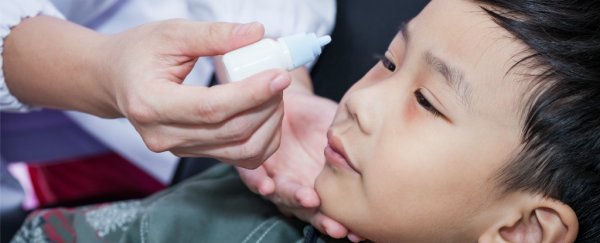The results of a five-year trial have shown that medicated eye drops can slow down the progression of nearsightedness by around 50 percent, and are a safe first line of defence against the rapidly growing epidemic of nearsightedness, or myopia, in children.
Epidemic may sound like a pretty extreme word for something as seemingly innocuous as shortsightedness, but right now in the US around 42 percent of the population is myopic, a huge jump from the 25 percent that were shortsighted in the '70s. In developed Asian countries, the rates are as high as 80 and 90 percent among young adults.
And even though vision can be corrected with glasses, contact lenses, and surgery, in severe cases the condition can lead to retinal detachment, macular degeneration, or even premature cataracts.
But the new research suggests that eye drops containing 0.01 percent of a medication known as atropine could help to reduce that risk and safely slow down the progression of the disease.
Atropine is commonly used to treat lazy eye and has been shown to have some benefits when it comes to shortsightedness, as it inhibits axial growth of the eye, which is associated with myopia. But no long-term studies had been completed on how to best use the drops, and doctors are wary of them due to potential side effects.
"For a long time we've known that atropine drops can help keep myopia from getting worse to some degree," said lead researcher Donald T. Tan, an ophthalmologist from the Singapore Eye Research Institute and the National Singapore Eye Centre. "We now have data showing that it is not only effective, but also safe."
Tan's study began back in 2006, when his team selected 400 Singaporean children aged between 6 and 12. Each one was randomly assigned a different dose of atropine drops – either 0.5, 0.1, or 0.01 percent.
After the first two years, the children stopped taking the medication for 12 months while their vision continued to be tested. The researchers noticed that the vision of those given the stronger dose eye drops had become more myopic during that year off, so they gave those children the 0.01 percent dose of drops for another two years.
The results, presented at the annual meeting of the American Academy of Ophthalmology this week, were striking: after the five years, children who had used the lowest dose 0.01 percent eye drops were far less myopic than their peers taking the stronger drops.
The drops also appeared safe for all the participants to use throughout the length of the study, and compared to an earlier study on the untreated progression of myopia, the team showed that the 0.01 percent drops slowed down shortsightedness by around 50 percent.
The reason doctors have been slow to use atropine to treat myopia is that, in higher doses, it can have some concerning side effects such as allergic conjunctivitis and pupil dilation, which can cause light sensitivity and blurry vision when looking at objects up close.
While these symptoms were seen in the children using the high dose drops during the study, those who used the 0.01 percent dose had pupil dilation of less than 1 mm, which minimised light sensitivity. The children also reported experiencing minimal near-vision loss after using the low-dose drops, and the researchers suggest that the benefits of the medication outweigh these risks.
"Combined with other interventions, this treatment could become a great ally in preventing myopia from causing serious visual impairment in children worldwide," said Tan.
That said, more research needs to be done on the long-term safety of the drops, particularly on which children they should be used, seeing as around 9 percent of the participants in the low-dose group of the study didn't respond to the drops at all.
Further studies are currently happening in Europe and Japan, and will hopefully provide more information. If we could find a cheap and easy way to reduce the number of people suffering from myopia, that would be pretty incredible.
